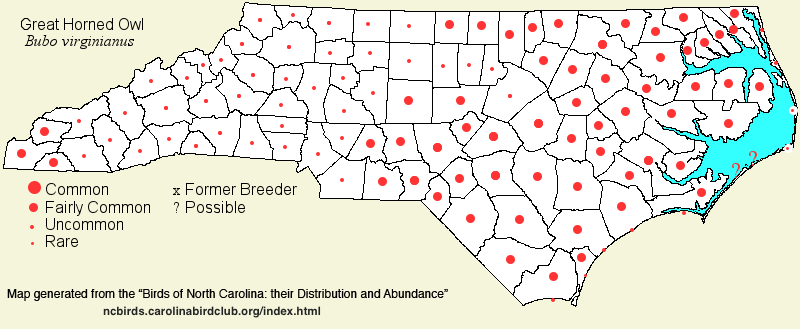 |  |
|
Great Horned Owl - Bubo virginianus STRIGIDAE Members: | Search Common: Search Scientific: |
|
|
|||||||
| General Comments | This is the largest of the breeding owls in the state, and as with the Eastern Screech-Owl, the Great Horned Owl nests in all 100 counties. The species still fares well in the presence of man, though much habitat has been lost to development. This nocturnal species favors open to medium-growth pine forests, or mixed forests, preferably in dry to mesic areas, leaving the wetlands to the Barred Owl; thus, it is the nocturnal counterpart of the Red-tailed Hawk. As with the hawk, most territories contain extensive fields, and owls can sometimes be seen at dusk perched on stubs, bare trees, or poles in fields. Despite their proclivity toward drier areas, Great Horned Owls are often found in pine stands adjacent to tidal marshes and other such wetlands. It appears to be completely non-migratory. | ||||||
| Breeding Status | Breeder | ||||||
| NC BRC List | Definitive | ||||||
| State Status | |||||||
| U.S. Status | |||||||
| State Rank | S5 | ||||||
| Global Rank | G5 | ||||||
| Coastal Plain | Permanent resident. Generally fairly common across the province, both along the coast and inland to the Fall Line. Peak counts: 34, Roanoke Rapids CBC, 1 Jan 1984. | ||||||
| Piedmont | Permanent resident. Uncommon to fairly common across the province. Peak counts: | ||||||
| Mountains | Permanent resident. Uncommon over most of the province, but perhaps fairly common in some areas. Ranges up to about 5,000 feet. Peak counts: | ||||||
| Finding Tips |
Great Horned Owls call mainly during the colder months, mostly from Nov or Dec into Mar. At this time, one can often hear them calling at twilight, especially near dawn. They call less frequently in the middle of the night. A pair will often duet, with the high-pitched female's call alternating with the low-pitched male's call.
To see a Great Horned, your best bet is to look during twilight conditions around fields, clearcuts, and other open areas. The owls often perch in tall dead trees, and they may also perch on telephone poles. You can see their silhouette, and then spotlight them with a flashlight. *** | ||||||
| Attribution | LeGrand[2023-03-21], LeGrand[2012-07-11], LeGrand[2011-12-07] | ||||||
| NC Map Map depicts all counties with a report (transient or resident) for the species. | Click on county for list of all known species. |
| NC Breeding Season Map Map depicts assumed breeding season abundance for the species. |  |